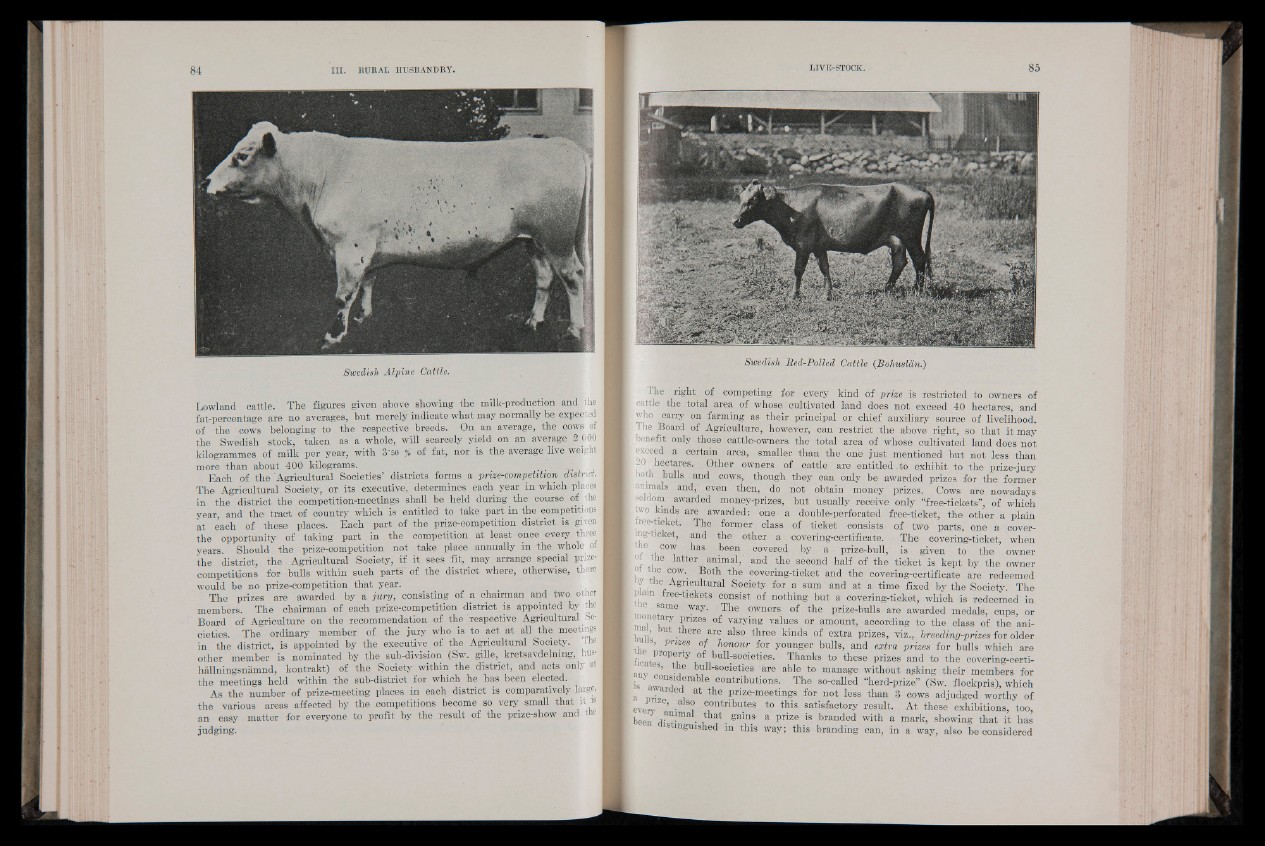
Swedish Alpine Cattle.
Lowland cattle/ The figures given above showing the milk-produetion and|the
fat-percentage are no averages, but merely indicate what may normally be oxpeci.ti
of the cows belonging to the respective breeds. On an average, the cows of
the Swedish stock, taken as a whole, will scarcely yield on an average 2;000
kilogrammes of milk per year, with 3'50 % of fat, nor is..the average live weight
more than about 400 kilograms. . . . . .
Each of the ‘Agricultural Societies’ districts forms , a prize-competition district.
The Agricultural Society, or its executive, determines each year in which places
in the district the competition-meetings shall be held during the course of the
year, and the tract of country which is entitled to take part in the competitions
at each of these places. Each part of the prize-competition district is given
the opportunity of taking part in the competition at least once every three
years. Should the prize-competition not take place annually in the whole of
the district, the Agricultural Society, H it sees fit, may arrange special prize-
competitions for hulls within such parts of the district where, otherwise, there
would be no prize-competition that year.
The prizes are awarded by a jury, consisting of a chairman and two- other
members. The chairman of each prize-competition district is appointed by the
Board of Agriculture on the recommendation of the respective Agricultural Societies.
The ordinary member of the jury who is to act at all the meetings
in the district, is appointed by the executive of the Agricultural Society. The
other member is nominated by the sub-division (Sw. gille, kretsavdelmng, hus-
hallningsnamnd, kontrakt) of the Society within the district, and acts only at
the meetings held within the sub-district for which he has been elected.
As the number of prize-meeting places in each district is comparatively large,
the various areas affected by the competitions become so very small that it »
an easy matter for everyone to profit by the result of the prize-show and the
judging.
Swedish Red-Polled Cattle (Bohusldn.)
The right of competing for every kind of prize is restricted to owners of
cattle the total area of whose cultivated land does not exceed 40 hectares, and
who carry on farming as their principal or chief auxiliary source of livelihood.
The Board of Agriculture, however, can restrict the above right, so that it may
benefit only those cattle-owners the total area of whose cultivated land does not
exceed a certain area, smaller than the one just mentioned but not less than
20 hectares.- Other owners of cattle are entitled .to exhibit to the prize-jury
jboth bulls and cows, though they can only be awarded prizes for the former
animals and,’ even then, do not obtain money prizes. Cows are nowadays
v seldom awarded money-prizes, hut usually receive only “free-tickets”, of which
two kinds are awarded: one a double-perforated free-ticket, the other a plain
iree-ticket. The former class of ticket consists of two parts, one a covering
ticket, and the other a covering-certificate. The coyering-ticket, when
e cow has- been covered by a prize-bull, is given to the owner
°1 the . latter animal, and the second half of the ticket is kept by the owner
o tte cow. Both the covering-ticket and the covering-certificate are redeemed
>y the Agricultural Society for a sum and at a time fixed by the Society. The
Plain free-tickets consist of nothing but a covering-ticket, which is redeemed in
mo I™ 6 ^ ay‘ owners of tbe Prize-bulls are awarded medals, cups, or
j , Y Trizes of varying values or amount, according to the class of the ani-
buV Ut . re aro also tbree kinds , of extra prizes, viz., breeding-prizes for older
the I m z e s honour. f?r younger bulls, and extra prizes for bulls which are
ficatPr°I>thty ran knihsocieties. Thanks to these prizes and to the covering-certi-
arv !?’ , buU-societies are able to manage without agking their members for
T te s°-caIled “herd-prize” (Sw. flockpris), which
a nil l at Pnze-meetings for not less than 3 cows adjudged worthy of
everv **’ • i contriblltes to this satisfactory result. At these .exhibitions, too,
been dwr • MKMh H a prize is branded with a mark, showing that it has
mguished in this way; this branding can, in a way, also he considered